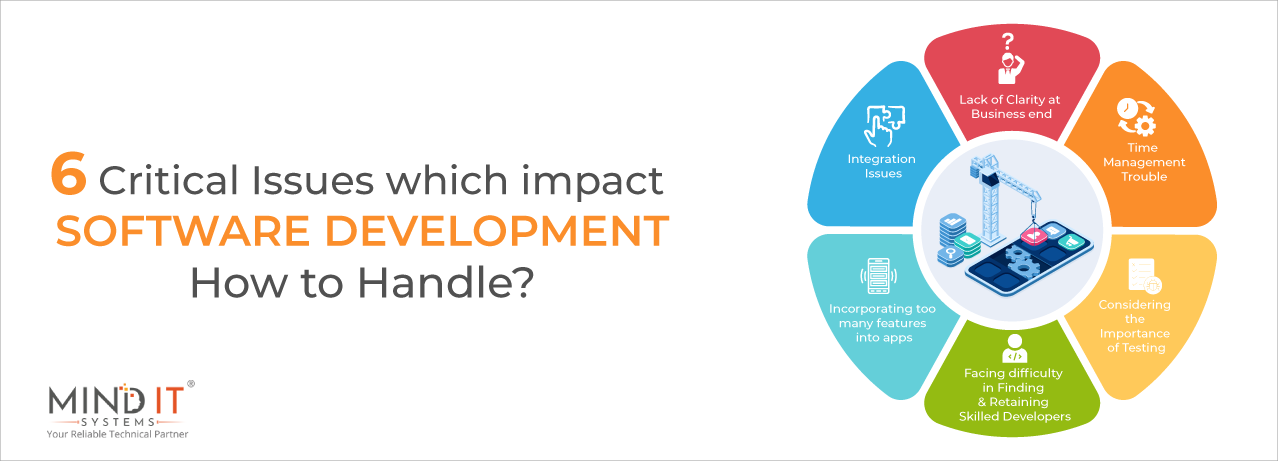
6 Critical Issues which impact Software Development – How to Handle?
The most challenging problems in software development lie outside the code.
It isn’t the code that only matters for a successful software application. The development of fully functional software applications needs a lot of planning and strategizing before writing a single line of code.
Often times, it is noticed 31.1% of projects get canceled before their completion, and around 52.7% of projects overrun the budget. Different factors can derail the software engineering process, like lack of knowledge about the technology stack, technical skills proficiency levels, budget, major pivoting in development tracks midway etc.
This article aims to help you look closely at the six critical issues which can impact the software development cycle and the solutions to overcome them.
Let’s delve in!
The 6 Critical Issues which can impact Software Development
No #1
Lack of Clarity at Business end: Unable to Outline Correctly the Ideal Users
It is essential for product owner to define target audiences correctly. Failing to find or define the app’s target audience precisely can lead to a severe hold-up in the software development operation, or rework. Often, software developed might be well-organized and functional, but if it has no market value, in that case, the development can be a colossal waste of time, money, and effort.
Solution:
An excellent way to overcome this hurdle is to conduct thorough market research and check out your target audience before planning to go ahead with your product development.
No #2
Time Management Trouble: Incorrect estimations and leaving no room in planning for any errors.
Managing time and planning correctly is one of the important requirements in the software development lifecycle. In the initial stages, many software engineering firms overestimate their resources and underestimate the time needed to launch a product. As a result, it can cause you to face issues like delays in the delivery of the products on time, problems with quality, reorganizing marketing campaigns and budget overruns.
Solution:
An effective way to handle time management challenges is to opt for an Agile software development methodology. Agile methodologies call for speedy and flexible processes. Since the process is iterative changes based; this enables teams to work quickly on formalized planning.
In addition, the Agile style offers scope for every team member to share progress and discuss the risks or roadblocks they encounter, thus allowing each member to calculate the time needed for accomplishment of any tasks and progress accordingly. The last level planning is done in smaller chunks, which works out better as it can consider any latest dependencies.
No #3
Considering the Importance of Testing: Test and Automate continuously
Quality Assurance plays a crucial role in the software development cycle, which software developers sometimes disregard in attempting to swiftly complete tasks when they are under tight deadlines.
QA encompasses more than just checking for bugs and programming-related severe problems. Testing software ensures dependability, security, and high performance, which results in time savings, cost savings, and customer satisfaction.
Solution:
It can be decisive for a business organization to outsource jobs to Quality Testers who can check the product, discover the defects or issues, generate a report, and work with software developers continuously to fix the problems, thus making the end product ready to introduce to the users. Automation of testing is also important to effectively save time and money.
No #4
Facing difficulty in Finding & Retaining Skilled Developers: A global challenge
Finding the most talented and skilled software teams and retaining them is quite a tedious job. The things that primarily can create obstacles in searching for the right talent include – a need for more highly experienced developers for particular coding skills based on languages or platforms and the high cost of hiring. Your competitors also contribute to the scarcity of relevant talent and the higher costs.
Solution:
A good way for business organizations to mitigate a situation like shortage of talents or difficulty in retaining skills causing the timeline and project knowledge to be at risk can be –
- Outsourcing projects to a reliable tech partner
- Hiring dedicated Indian app developers on an hourly or a monthly basis
- Getting a dedicated development team along with QA and designers, which can operate as a standalone unit
- Extending the workforce by collaborating with an IT staff augmentation services provider that has a proven track record.
No #5
Incorporating too many features into apps: Build expectations which are real
The temptation to include too many features in one application can result in complicating the software development tracks. It may lead to developing a software product that tries to do everything but proves inadequate in the crucial areas of functionality, or does not deliver the required performance levels.
Solution:
Concentrate on creating an app that specializes in one to three core functionalities rather than creating a sophisticated app in the first go. Scope creep Is dangerous when it starts happening along with development. At business level, this ultimately leads to delays and lack of quality, which defeats the entire purpose of building the app. Future development should be planned around essential features by prioritizing clearly and keeping a product roadmap visible to entire team.

No #6
Integration issues
Lastly, integrations may create roadblocks in the software development life cycle. They can jeopardize a project’s scope, budget, and timeframe, if not planned correctly. An instance of this issue is when your software interfaces with a third-party API, but that API needs more functionality or is late in releasing it. Failing to provide appropriate expectations regarding timeline and functionality can result in delays in co-development using a third-party API, thus causing delays in your project’s overall timeframe.
Solution:
An excellent way to handle such issues is to analyze the proposed system integration requirements and gather pertinent information. It also entails examining the integration success criteria, such as keeping your system simple, selecting suitable integration tools, preferring smaller integrations over extensive integrations, etc. Getting in touch with specialized IT consultants to assess the current infrastructure, shortcomings, and requirements can be a wise decision for enterprises here. If there is any potential showstopper risk with a specific integration, build your Plan-B beforehand.
Final Comments
Solving software product development challenges is a daunting task for small or established organizations. Businesses need to plan their projects meticulously, conduct good market research to analyze the app’s target audience correctly, and build products that satisfy customers’ requirements. From capturing a new market, integrating new technologies, building products for evolving markets, and to maintaining end to end security, enterprises and software developers need to be focused and clear about their goals to achieve success.
Are you looking out for tech experts to guide you or assist you in making your software development cycle successful? Contact us TODAY!
Share this post
About the Author

Sujoy Roy
(Head – Digital Marketing)
From my teenage time, I had a quench to solve problems and loved leadership. Starting my career in relation management, ignited my passion for managing people. While managing I realized technology needs to be incorporated to keep pace with the changing world & do my work efficiently.

